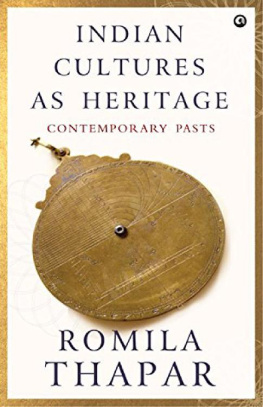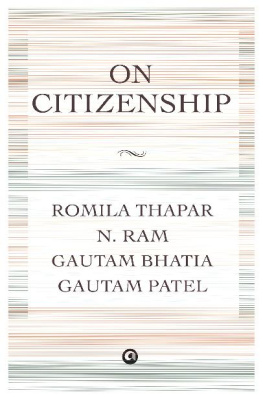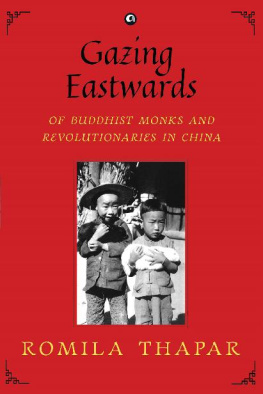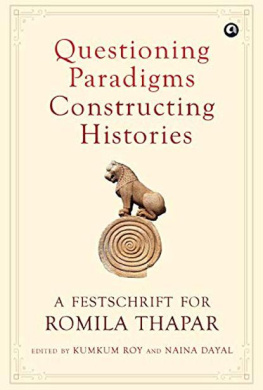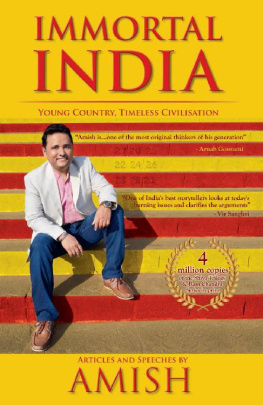PENGUIN BOOKS
THE PENGUIN HISTORY OF EARLY INDIA
Romila Thapar was born in India in 1931 and comes from a Punjabi family, spending her early years in various parts of India. She took her first degree from Punjab University and her doctorate from London University. She was appointed to a Readership at Delhi University and subsequently to the Chair in Ancient Indian History at the Jawaharlal Nehru University, New Delhi, where she is now Emeritus Professor in History. Romila Thapar is also an Honorary Fellow of Lady Margaret Hall, Oxford, and has been a Visiting Professor at Cornell University and the University of Pennsylvania as well as the Collge de France in Paris. In 1983 she was elected General President of the Indian History Congress and in 1999 a Corresponding Fellow of the British Academy.
Among her publications are Ashoka and the Decline of the Mauryas, Ancient Indian Social History: Some Interpretations, From Lineage to State, History and Beyond, Sakuntala: Texts, Readings, Histories and Cultural Pasts: Essays on Indian History, as well as a childrens book, Indian Tales.
ROMILA THAPAR
The Penguin History of Early India
FROM THE ORIGINS TO AD 1300

PENGUIN BOOKS
PENGUIN BOOKS
Published by the Penguin Group
Penguin Books Ltd, 80 Strand, London WC2R 0RL , England
Penguin Putnam Inc., 375 Hudson Street, New York, New York 10014, USA
Penguin Books Australia Ltd, 250 Camberwell Road, Camberwell, Victoria 3124, Australia
Penguin Books Canada Ltd, 10 Alcorn Avenue, Toronto, Ontario, Canada M4V 382
Penguin Books India (P) Ltd, 11 Community Centre,
Panchsheel Park, New Delhi 110 017, India
Penguin Books (NZ) Ltd, Cnr Rosedale and Airborne Roads,
Albany, Auckland, New Zealand
Penguin Books (South Africa) (Pty) Ltd, 24 Sturdee Avenue,
Rosebank 2196, South Africa
Penguin Books Ltd, Registered Offices: 80 Strand, London WC2R 0RL , England
www.penguin.com
First published as Early India by Allen Lane The Penguin Press 2002
Published under the present title in Penguin Books 2003
7
Copyright Romila Thapar, 2002
All rights reserved
The moral right of the author has been asserted
Except in the United States of America, this book is sold subject
to the condition that it shall not, by way of trade or otherwise, be lent,
re-sold, hired out, or otherwise circulated without the publishers
prior consent in any form of binding or cover other than that in
which it is published and without a similar condition including this
condition being imposed on the subsequent purchaser
978-0-14-193742-7
For Sergei: in memoriam
and
remembering Kaushalya and Daya Ram and our many years together
Contents
List of Illustrations
FIGURES
MAPS
The external boundaries of India as depicted in the maps are neither correct nor authentic.
Preface
It has been almost four decades since the first version of this book was written and in that time there have been substantial changes in the readings of Indian history. These have come about as a result of some new data, together with many fresh interpretations of the known data. My attempt here has been to incorporate the essentials of the new data and interpretations while retaining some of the older arguments where they are still relevant.
A major amendment to this book lies in its chronological span. It now closes at c. AD 1300 instead of AD 1526 as in the earlier version. After many years, I have finally persuaded Penguin that the history of India should be covered in three volumes and not be restricted to two. The earlier division of two volumes did not do justice to the important period from c. AD 1300 to 1800 and this is now being corrected. The final volume will bring the narrative up to contemporary times. This change also provides more space for each volume. An introduction already exists to the pre-history and proto-history of India in the volume by F. R. and B. Allchin, The Birth of Indian Civilisation, revised in 1993, also published by Penguin, as well as The Origins of a Civilization by the same authors and published by Viking in 1997 (Penguin, 1998). I have therefore given only a brief overview of prehistory and protohistory.
In the course of writing this book I have drawn on many friends for comments on various chapters of an earlier draft. Among them I would like to thank R. Champakalakshmi, Madhav Gadgil, Dennis Hudson, Xinru Liu, Michael Meister, Vivek Nanda and K. N. Panikkar. My special thanks go to Susan Reynolds, not only for observations on specific chapters but also for many conversations about the book. I was delighted when Ravi Dayal suggested that he might like to read the penultimate draft and ploughed his way through it, with helpful remarks on what he had read. Nainas postings of not clear have hopefully made the narrative more lucid. Lucy Peck gallantly agreed to do rough drafts of all the maps, thus allowing me to include maps relating to every chapter. I would also like to thank the Homi Bhabha Fellowships Council for the award of a Senior Fellowship. The research carried out during this period contributed to the shaping of the earlier half of this book. And I would also like to thank David Ludden for arranging a series of lectures at the University of Pennsylvania which broadly covered the same themes.
Gene Smith was fantastically generous with time and effort when he painstakingly scanned the earlier version onto disk and this made the mechanics of rewriting much easier. Shirish and Gautam Patel and Chris Gomes have been unruffled by my frequent cries for help when the computer behaved unpredictably, and have patiently set me right, a patience also shown by Vivek Sharma. Rajani was the one person who over the years kept insisting that I revise the earlier book, and finally her insistence has had effect.
Romila Thapar
New Delhi
2001
Acknowledgements
Every effort has been made to contact copyright holders. The publishers shall be happy to make good in future editions any errors or omissions brought to their attention. The author would like to thank the following for permission to use copyright material in this book: extract from The Universal History of Numbers by George Ifrah published by the Harvill Press and used by permission of the Random House Group Ltd; extract from R. Parthasarathys translation of The Tale of an Anklet by permission of Columbia University Press; extract from S. Radhakrishnans translation of The Principle Upanisads by permission of HarperCollins Publishers; extracts from Nilakantha Sastris The Colas and Romila Thapars Asoka and the Decline of the Mauryas by permission of Oxford University Press, New Delhi; extract from Ronald Lathams translation of The Travels of Marco Polo by permission of Penguin Books Ltd; extracts from A. K. Ramanujams translations of Hymns for the Drowning by permission of Princeton University Press; extracts from A. L. Bashams The Wonder that was India by permission of Macmillan Publishers; extracts from Indira V. Petersons Poems to Siva: The Hymns of the Tamil Saints by permission of the author; illustration of Nagara-style temple by permission of Michael Meister; Circular Deri temple plan by permission of Vidya Dehejia; Circular Devi temple plan by permission of Nilakanta Sastri and A. K. Ramanujan.
Note on the Bibliographies
A General Bibliography is included at the end of the book, with a broad coverage of books providing introductions to major aspects of the subject.
Select Bibliographies in the nature of further readings and specific to each chapter are grouped according to chapters and their subheadings. Books are listed in the order of the subject matter discussed within the text.


